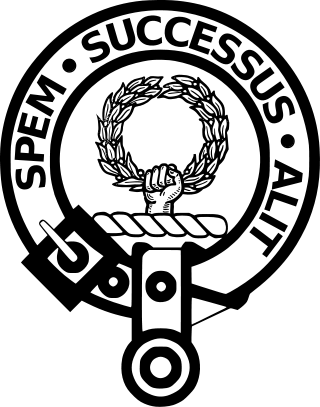
Clan Ross is a Highland Scottish clan. The original chiefs of the clan were the original Earls of Ross.

Vice-Admiral Sir John Lockhart-Ross, 6th Baronet, known as John Lockhart from 1721 to 1760, was an officer of the Royal Navy who saw service during the War of the Austrian Succession, Seven Years' War, and the American War of Independence, and served for a time as a Member of Parliament.
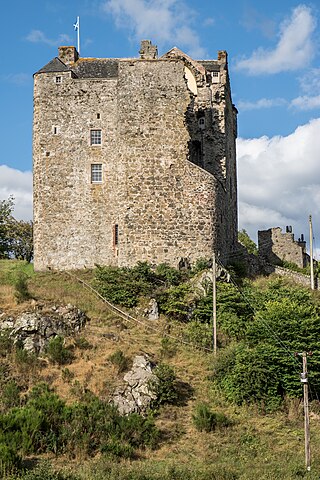
Neidpath Castle is an L-plan rubble-built tower house, overlooking the River Tweed about 1 mile (1.6 km) west of Peebles in the Borders of Scotland. The castle is both a wedding venue and filming location and can be viewed by appointment.

Sir Charles Henry Augustus Frederick Lockhart Ross, 9th Baronet was a Scottish inventor and commercial entrepreneur who invented the innovative and often controversial straight-pull actioned Ross rifle.

The House of Burnett is a Lowland and Border Scottish family composed of several branches. The Chief of the Name and Arms of Burnett is James Comyn Amherst Burnett of Leys.

John Charles Ogilvy-Grant, 7th Earl of Seafield, KT, styled Viscount Reidhaven from 1840 to 1853, was a Scottish nobleman. He is numbered as the 26th Chief of Clan Grant.

Clan Cunningham is a Scottish clan. The traditional origins of the clan are placed in the 12th century. However, the first contemporary record of the clan chiefs is in the thirteenth century. The chiefs of the Clan Cunningham supported Robert the Bruce during the Wars of Scottish Independence. In the 15th and 16th centuries, the Clan Cunningham feuded with the Clan Montgomery. Historically, the chief of Clan Cunningham held the title of Earl of Glencairn. However, in modern times the chief of the clan is Cunningham of Corsehill. On 18 December 2013, Sir John Christopher Foggo Montgomery Cunninghame, Baronet of Corsehill, was recognized by Lord Lyon as Clan Chief after the chiefship had been vacant for over 200 years.

Clan Moncreiffe is a Highland Scottish clan.
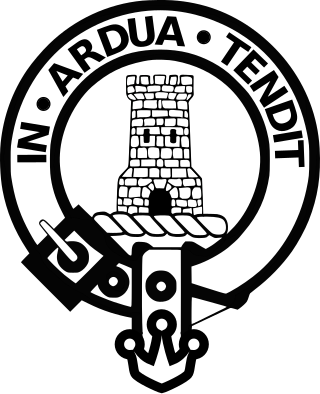
The Clan Malcolm, also known as the Clan MacCallum, is a Highland Scottish clan. The Clan MacCallum may have originally been a separate clan until the 18th century, when the chief of the Clan MacCallum adopted the name Malcolm after inheriting the Malcolm estate, and the two clans were drawn together under the same chief.

The Battle of Aldy Charrish was a Scottish clan battle that took place on 11 July 1487. The Clan Mackay and possibly the Clan Sutherland defeated the Clan Ross and their allies in the Scottish Highlands, probably on the south side of Strathoykel.
There have been two baronetcies created for members of the Haggerston, later Constable Maxwell-Scott family, one in the Baronetage of England and one in the Baronetage of the United Kingdom. Only one creation is extant as of 2008. The Haggerston, later Constable Maxwell-Scott Baronetcy, of Haggerston in the County of Northumberland, was created in the Baronetage of England on 15 August 1642 for Thomas Haggerston, of Haggerton Castle, Northumberland, a loyal Royalist who served as a colonel in the army of King Charles I. The Haggerston were recusant in the 17th century and the estates were sequestered and forfeit to the Commonwealth of England in 1649 but were repurchased by the first Baronet in 1653. The line of the fourth Baronet failed on the death of the twelfth Baronet in 1972. The title reverted to the line of William Haggerston, second son of the third Baronet and younger brother of the fourth Baronet. In 1746 he inherited estates in Yorkshire from his great-uncle Sir Marmaduke Francis Constable, 4th and last Baronet, of Everingham, and assumed the surname of Constable in lieu of his patronymic. In 1758 he married Winifred, daughter of Robert Maxwell, titular sixth Earl of Nithsdale, and assumed by Royal licence the additional surname of Maxwell. Winifred was considered to be the heiress to the Scottish lordship of Herries of Terregles held by her father. Constable-Maxwell built a new house at Everingham Park on the Constable estate in Yorkshire.
The title of Lord Ross was a Lordship of Parliament in the Peerage of Scotland. It was created in 1499 for Sir John Ross, of Halkhead.
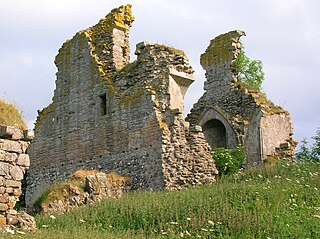
Craigie Castle, in the old Barony of Craigie, is a ruined fortification situated about 4 miles (6.4 km) southeast of Kilmarnock and 1 mile (1.6 km) southeast of Craigie village, in the Civil Parish of Craigie, South Ayrshire, Scotland. The castle is recognised as one of the earliest buildings in the county. It lies about 1.25 miles (2 km) west-south-west of Craigie church. Craigie Castle is protected as a scheduled monument.
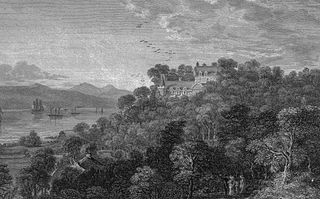
Skelmorlie Castle stands on the eastern shore of the Firth of Clyde, Scotland, at the north-western corner of the county of Ayrshire. The structure dates from 1502, and was formerly the seat and stronghold of the Montgomery Clan. The modern village of Skelmorlie lies to the north of the castle.
George Ross, 11th Lord Ross of Halkhead, was a Scottish nobleman and soldier.
George Ross, 13th Lord Ross of Halkhead, was a Scottish nobleman.
William Ross, 14th Lord Ross of Halkhead, was a Scottish nobleman.

Clan Munro is a Highland Scottish clan. Historically the clan was based in Easter Ross in the Scottish Highlands. Traditional origins of the clan give its founder as Donald Munro who came from the north of Ireland and settled in Scotland in the eleventh century, though its true founder may have lived much later. It is also a strong tradition that the Munro chiefs supported Robert the Bruce during the Wars of Scottish Independence. The first proven clan chief on record however is Robert de Munro who died in 1369; his father is mentioned but not named in a number of charters. The clan chiefs originally held land principally at Findon on the Black Isle but exchanged it in 1350 for Estirfowlys. Robert's son Hugh who died in 1425 was the first of the family to be styled "of Foulis", despite which clan genealogies describe him as 9th baron.

Lee Castle, also known as The Lee, is a castellated mansion in Auchenglen, a branch of the Clyde Valley in South Lanarkshire, Scotland. It is located 1.5 kilometres (0.93 mi) south of Braidwood, and 4 kilometres (2.5 mi) north-west of Lanark. Lee was the seat of the Lockharts of Lee from its establishment in the 13th century until 1919, though the present house is the result of rebuilding in the 19th century.
Sir Charles Lockhart-Ross, 7th Baronet was a Scottish landowner, politician, and officer in the British Army.















